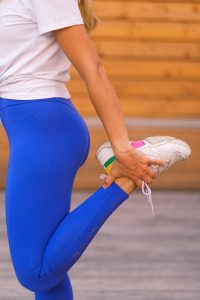
What is this Calf Strain?
Calf Muscle strains typically occur in bi-articular muscles and are defined as overstretching or, in severe cases, tearing of muscles, usually as a result of eccentrically overloading an already stretched muscle.
What causes this Calf Strain?
In the case of calf strains, injury most commonly involves the medial head of gastrocnemius; however, strains to the lateral head of gastroc, soleus or plantaris muscles can also occur. Calf strains are most prevalent in athletic populations (i.e. sports which require sprinting and high-volume running) and often result from sudden acceleration or deceleration. Activities involving slow and powerful eccentric calf contractions, such as ballet dancing or walking uphill, can also result in calf strains.
Calf strains can be categorized into 3 grades:
- Grade I: mild overstretch with <10% disruption to muscle fibres. Expected recovery in 1-3 weeks.
- Grade II: moderate overstretch with a partial tear of muscle, often marked with bruising. Pain with active/passive ankle dorsiflexion, with clear loss of ROM and strength. Muscle fibre distruption between 10-50%. Expected recovery in 3-6 weeks.
- Grade III: severe or complete rupture of muscle, accompanied by pain, swelling, bruising and palpable diastasis. Surgical intervention is usually indicated. Recovery time can take between 6 weeks to 6 months.
Differential Diagnosis
- Muscle cramp
- Achilles rupture
- Achilles tendinopathy
- Deep vein thrombosis
- Referred pain from lower back region
- Exertional compartment syndrome – increased intramuscular blood flow that leads to increased compartmental pressure and can cause capillary compression and ischaemia. Symptoms include muscle cramping, parasthaesia, numbness and weakness in lower leg.
- Popliteal artery entrapment syndrome (PAES) – compression of artery between popliteal muscle and bone, usually caused by active plantarflexion
- Baker’s cyst
Common symptoms / signs
- Sharp pain in the calf region
- ‘pop’ at time of injury
- Bruising and/or swelling
- Tight feeling in the calf
- Reduced active and passive ankle dorsiflexion ROM, limited by pain
- Reduced ankle dorsiflexion strength
- Pain with walking, hopping, walking uphill, stairs
How is Calf Pain treated?
1) Acute management of calf strains include pain management and early mobilization. As with any soft tissue injuries, it is recommended that individuals follow the PEACE and LOVE protocol.1
Acute inflammatory phase (in first 3-5 days post injury):
- Protect – unload or restrict movement (especially ankle dorsiflexion of affected calf). Move only within limits of pain.
- Elevate
- Avoid anti-inflammatory modalities – it has been suggested that NSAIDs and ice may hinder important healing effects of the inflammation process
- Compress
- Educate – individuals should be empowered to take an active approach to recovery. Education should include basic information about their condition, how to safely manage load, rehab expectations and recovery timeline.
After acute inflammatory period:
- Load – gradual, pain-free, loading promotes tissue remodelling and repair.2
- Optimism – Catastrophizing and fear-avoidant behaviors may place individuals at an increased risk of developing chronic pain conditions. Address these by educating, managing expectations, and encouraging optimism.
- Vascularization – pain-free early mobilization and aerobic exercise helps facilitate recovery by increasing blood flow to the injured site, improving function and even reducing need for pain medication.
- Exercise – physiotherapist-guided exercise not only provides the benefits stated above, it also aims to restore normal muscle function and reduce risk of re-injury
2) Once the individual is pain controlled, a home exercise may be started. Exercises and progressions may include3:
- Double leg calf raises in standing (3×8-20reps)
o Progress by increasing time under tension, adding resistance (i.e. weight calf raises), or progress to single leg
- Calf raises in wall sit
o Progress as above
- Toe taps (3×20-30reps)
o Rise onto toes and alternate tapping foot forward. Aim to spend 4sec on each rep.
- Pogo jumps
o Double leg – starting with 4x15sec à 4x30sec à 2x1min
o Progress to dynamic hopping (i.e. low box jumps, hops for distance, hops side-side) or to single leg
- Aerobic exercises – i.e. cycling or swimming
3) Return to sport
- Symmetry in calf strength should be regularly assessed before return to sport. Ideally, athletes should be able to complete 25-30 continuous reps with good form. A discrepancy of >5 reps is clinically significant and should be further addressed.
- Exercises at this stage should be sport-specific in order to restore meaningful muscle function and reduce risk of re-injury.
Risk factors of this Calf Strain?
- Age (35-50 years)
- Past history of calf strain
- Previous lower limb injuries (hamstring, quadriceps, adductor and/or knee)
- Lumbar spine pathology? (Researchers hypothesized that L5 nerve root entrapment may be associated with age-related predisposition to hamstring and calf strains.5)
Other causes?
- Insufficient warm-up
- ‘Weekend warrior’-type athletes
- Playing surface
- Footwear
References
Dubois, B., & Esculier, J. F. (2020). Soft-tissue injuries simply need PEACE and LOVE.
Duchesne, E., Dufresne, S. S., & Dumont, N. A. (2017). Impact of inflammation and anti-inflammatory modalities on skeletal muscle healing: from fundamental research to the clinic. Physical therapy, 97(8), 807-817.
Beer, B. 2021. How to rehab calf strains in runners. https://www.runnerstribe.com/features/how-to-rehab-calf-strains-in-runners/
Brukner, P. (2017). Clinical sports medicine: Injuries. McGraw-Hill Education (Australia) Pty Limited
Green, B., & Pizzari, T. (2017). Calf muscle strain injuries in sport: a systematic review of risk factors for injury. British journal of sports medicine, 51(16), 1189-1194
Orchard, J. W., Farhart, P., & Leopold, C. (2004). Lumbar spine region pathology and hamstring and calf injuries in athletes: is there a connection?. British Journal of Sports Medicine, 38(4), 502-504.
